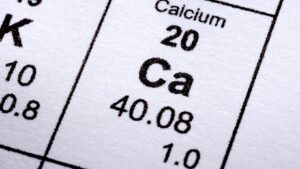Understanding the electron configuration of elements is key to unraveling the mysteries of the periodic table. One such element that’s often explored is Calcium (Ca) ca electron configuration. With an atomic number of 20, it’s nestled in the fourth period and second group, making it a fascinating subject in the world of chemistry.
The electron configuration of Calcium can seem complex at first glance, but it’s actually quite straightforward when broken down. It’s a topic that’s not only crucial for chemistry enthusiasts but also for those venturing into the realms of physics and material science. So, let’s dive into the captivating world of electron arrangements and discover what makes Calcium tick.

Ca Electron Configuration
While trying to grasp the concept of electron configuration, one may feel like they’re navigating through a labyrinth. However, our discussion aims to clear that fog by simplifying this topic. Let’s dive in ca electron configuration.
Electron configuration reveals the distribution of electrons in an atom’s atomic shells. This arrangement is vital because it influences the chemical, thermal, and electrical properties of an element. Understanding the configuration offers valuable insight into how elements interact and bond with each other.
Quantum mechanics plays a crucial role in determining electron configuration. The Pauli Exclusion Principle, Aufbau Principle, and Hund’s rule are key quantum theories used to predict an atom’s electron structure. This configuration is usually represented using quantum numbers. Bear in mind that different elements have distinctive electron settings due to varying atomic numbers.
Take the example of the Ground State Electron Configuration, the lowest energy state of an atom. It provides the foundation for understanding electron configurations of elements. Comprehending this pattern is foundational to mastering atomic structure and properties in science subjects.
Time to drop the spotlight on our item of interest – Calcium. With an atomic number of 20, calcium’s electron configuration comes across as intricate. It’s not to be feared though; by using principles like the Aufbau Principle, its complexity can be comprehensively understood. While we continue to explore the depths of calcium’s configuration, visualize it as a puzzle waiting to be solved.

Understanding Electron Configuration Notation
This section will break down the complex language of electron configuration, particularly focusing on the symbols and notations. Mastering this language is a stepping stone to understanding the properties and behavior of atoms, like calcium.
Ground State Electron Configurations
In electron configuration notation, ground state configuration describes an atom where all its electrons are at their lowest energy levels. It’s the most stable and frequently occurring electron arrangement. In this state, each electron order in the atom is filled starting with the lowest energy level, following the rules set by the Aufbau principle.
Let’s take Calcium (Ca) with an atomic number of 20 as an example. Its ground state notation stands as 1s2 2s2 2p6 3s2 3p6 4s2. This indicates that in the lowest energy level (n=1), there are 2 electrons in the ‘s’ sub-level. This pattern continues up to the fourth level (n=4), where there are 2 electrons (taking total electron count to 20) remain ca electron configuration.
Excited State Electron Configurations
Exhilaratingly, atoms can also be in their excited states. In such instances, one or more electrons absorb energy and move from their original, lower energy level to a higher one. Importantly, these electron configurations are unstable compared to the ground state. They tend to revert back to the ground state by emitting the absorbed energy as light.

The notation for excited electron configuration may look similar to the ground state, but there’ll be a discernible difference. One or more electrons will jump from a lower level to a higher one. For instance, an excited state of calcium might look something like this; 1s2 2s2 2p6 3s2 3p6 3d1 4s1.
Looking at these two state notations, we understand that the electron configuration notation is not just a set of symbols and numbers. It’s a code to the secrets of each atom and their distinctive properties.
Electron Configuration and the Periodic Table
Navigating to the heart of the matter, electron configuration plays quite an instrumental role in the Periodic Table. It’s the relationship between electron configuration of each element that provides consistency and a sense of order to the Periodic Table. This interaction not only fosters understanding of atomic structures but also gives insights into the reactive nature of different elements.
Trends in Electron Configuration
When it comes to the Periodic Table, various trends are resultant of electron configuration. Each period correlates directly with principle quantum numbers and energy levels of an atom. It’s observed that elements in the same group or column share similar electron configurations at their outermost energy level, often termed as the valence level ca electron configuration.
This leads to similarities in physical and chemical properties. For instance, in Group 2 elements where Calcium (Ca) belongs, they’ve a common configuration of two electrons in their outermost shell. Hence, these elements are noted for their tendency to lose two electrons, rendering them with +2 charge in most reactions.
In the same vein, there’s a recurring pattern of electron distribution across periods, hence the creation of blocks (s, p, d, f) in the Periodic Table. For example, the s-block includes elements which have their highest energy electron in the s-orbital (like Calcium). Taken into account, it’s clear that electron configuration is not an isolated subject – it’s intertwined with the Periodic Table.
As we delve deeper into this subject, the context of ca electron configuration in Chemical Bonding calls for attention. This aspect further emphasises the importance of comprehending electron configuration in a broader specter of chemistry.
Importance of Electron Configuration in Chemistry
Diving deeper into the electron configuration, its relevance stretches far beyond just the architectural blueprint of an atom. It’s a critical component in the realm of chemistry and plays an instrumental role in understanding how atoms interact and bond with each other.

Electron configuration impacts chemical reactions and dictates the ways atoms interact to form compounds. With the knowledge of a substance’s electron arrangement, chemists can predict its potential chemical behavior.
Ca Electron Configuration – The Significance of Electron Configuration
Electron configuration’s pivotal role in chemistry can’t be overstated. It’s the key to unlock the mysteries of atomic interactions and chemical bonding. When you delve into the electron configuration, you’re essentially peering into the atom’s outermost shell, gaining insights into reactivity patterns and the nature of chemical bonds. It’s this knowledge that sets the stage for the Periodic Table’s organization, grouping elements with similar valence electron configurations.


More Stories
Why Ferrari Is the Perfect Choice for Dubai Roads
Rectangle Tool Berfungsi Untuk…: A Comprehensive Guide to Functions & Applications in Digital Design
VivaMax Sub Indo: Bridging the Filipino-Indonesian Streaming Experience